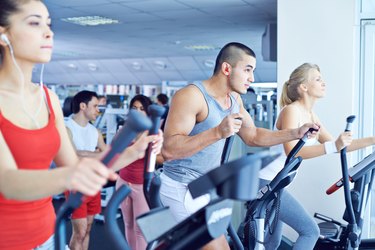
Some people may try to avoid the elliptical machine because they think it will bulk up their legs or create a bigger "elliptical butt." This is a complete myth, however, because the elliptical trainer does the exact opposite — it actually helps you slim down while improving muscle definition.
Tip
Doing the elliptical trainer does not make your legs and butt bigger. It actually can help you slim down, lose weight and tone your entire body — a win-win-win!
Video of the Day
Debunking the “Elliptical Butt” Myth
If you've ever used the term "elliptical butt" when referencing a larger backside, it's time to rethink your lingo. Why? Because, similar to other methods of cardiovascular exercise like running, jumping rope or swimming, the more you do the elliptical, the more calories you burn and the smaller in size you become. (That is, assuming your diet is in check.)
Video of the Day
Trainers say the idea of "elliptical butt" is a common misperception, probably because the elliptical machine also provides a resistance component that can leave your glutes, hamstrings and quads feeling wiped out after a workout session. But, this added resistance is one of the many ways the elliptical machine benefits your legs and butt.
Read more: Getting Cut vs. Bulking Up
Muscle is more dense than fat, which means a pound of fat takes up more space in your body than a pound of muscle. That said, the resistance training component added by the elliptical will only help replace fat mass with smaller, leaner muscle.
The cardiovascular component of the elliptical trainer strengthens another big and important muscle in your body, too — the heart — especially when you use the machine to do high-intensity interval training (HIIT). According to the American Council on Exercise, you can do a HIIT workout on the elliptical by alternating between bursts of intense work at an explosive speed (80 percent or higher of your max effort) followed by rest. For beginners, try a 30 second max effort interval, followed by 60 to 90 seconds of recovery. As you continue to train with HIIT workouts on the elliptical, the amount of time needed for recovery may decrease.
Read more: 5 Ways to Supercharge Your HIIT Routine
Additional Benefits of the Elliptical
In addition to burning calories and toning the lower half of your body, the elliptical trainer also helps you tone your upper body and abdominal muscles. Most elliptical trainers come with two long handles that resemble ski poles, allowing you to hold on while powering through your movements.
When you add more resistance to your elliptical machine's settings, it forces you to push and pull with your arms, just as you do with your legs. When this happens, it provides a good upper-body resistance workout and forces your abs to engage, as well, as you work head-to-toe to keep the machine moving at your desired pace. This full-body movement is a great calorie burner, and given that the Office on Women's Health reports that two in three women in the United States have overweight or obesity, this is important now more than ever.
Worth noting is that the elliptical machine also requires very minimal impact on your feet, knees and hip joints. Unlike the treadmill, your feet aren't pounding away as you take each stride. For this reason, the elliptical is a great cardio option for individuals who have obesity, people with injuries, those recovering from a surgery and, according to the Arthritis Foundation, even those with arthritis.
Read more: 8 Low-Impact Moves to Boost Power & Strength
- American Council on Exercise: “Try This HIIT Workout on the Elliptical Trainer”
- Harvard Health Publishing: “Interval Training for a Stronger Heart”
- Arthritis Foundation: “Elliptical”
- Office of Disease Prevention and Health Promotion: Dietary Guidelines for Americans 2015-2020
- Office on Women's Health:"Weight and Obesity"